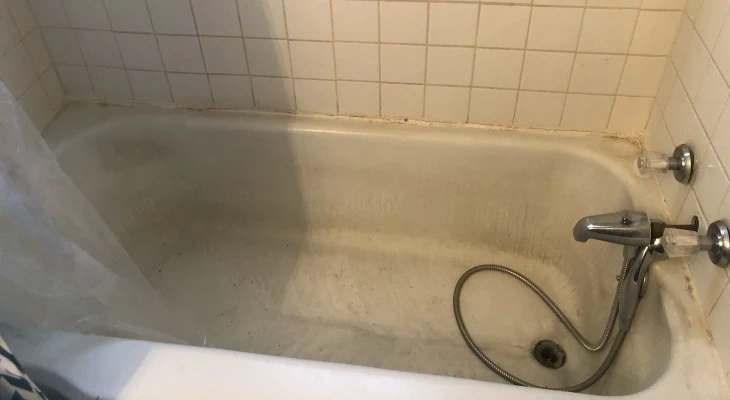You decided to clean the bathroom and went all out. The sink, the toilet, the tub all needed some elbow grease.
So, you give it all a good once over with the only cleaner you have left – the toilet cleaning solution. But after a good scrub, you return to find the tub streaked, grimy and ruined.
Now you’re wondering, “What happened?”
Unfortunately, the damage results from the simple and common mistake of using toilet cleaner on the tub. But the good news is that you can mitigate the damage and prevent further damage to your bathtub.
Table of Contents
Why Did the Toilet Cleaner Ruin the Tub?

Before exploring how to fix a toilet cleaner-damaged tub, you should understand why the solution damaged the tub in the first place.
After all, it’s easy to assume the toilet cleaner would work on most surfaces in the bathroom… So why didn’t it?
The answer is a simple one. Most toilet cleaners like Lysol contain harsh chemicals like bleach and other corrosive acids designed to break down bacteria and stains, usually only found in toilets.
These active ingredients are designed for a toilet’s sturdy materials and can damage the tub’s surface.
In general, you should never use toilet cleaners in a bathtub. Aside from the possible damage, their use can cause, the chemicals in toilet cleaners can leave harsh residues on the tub’s surface, which can prove harmful to people exposed to the chemicals through a bath in the tub.
How Can You Fix a Bathtub Damaged by Toilet Cleaner?
You can take several steps to try and repair the damage of toilet cleaners on your bathtub. However, your actions will depend on your tub’s materials and the extent of the damage.
If you have a cast iron tub, chances are excessive exposure to toilet cleaner will erode the finish on the tub – meaning you’ll have to hire a professional to reglaze the tub or risk rust.
Fiberglass tubs may require refinishing or touch-ups if the toilet cleaner has etched away at the tub’s surface.
However, if the cleaner has only been on the tub for a few hours at most, you may be able to salvage the tub without help from a professional by following one of the methods outlined below.
For Extensive Streaks or Discoloration of the Tub
Step One – Rinse Off the Toilet Cleaner

First things first, you need to remove all traces of the cleaning solution from the tub, or it will continue to eat away at the tub’s finish.
Next, rinse the tub to remove as much solution as possible before proceeding to step two.
Step Two – Strip Remaining Cleaner with Baking Soda
Dust the entire tub surface previously exposed to the cleaning solution with baking soda.
Baking soda is non-abrasive and won’t scratch the surface of porcelain or fiberglass. Baking soda can help remove traces of cleaning solution water could not.
Step Three – Scrub and Rinse
Grab a soft sponge or cloth and start scrubbing. Toilet cleaner can cling to surfaces, so elbow grease is required to remove it entirely from surfaces.
Step Four – Repeat as Necessary
Scrub and rinse repeatedly until any stains or streaks from the cleaner have faded entirely.
Step Five – Touch Up
After you have removed all traces of the toilet cleaner, you’ll want to look into the proper touch-up material for your tub.
Home improvement stores often offer a reglazing at-home kit for fiberglass and cast-iron tubs. You can also find these kits on Amazon.
If the tub requires extensive touch-ups, it’s best to contact a professional to avoid rust or water damage from improperly sealed touch-ups.
For Immediate Cleaning of the Solution
If you have accidentally used toilet cleaner on the tub and immediately notice your mistake, follow the same steps for removing extensive streaking.
For Additional Blue Discoloration

In some cases, depending on the toilet cleaner’s color, you may notice blue discoloration from the cleaner after scrubbing and cleaning away the toilet cleaning solution.
In that case, you can usually remove the stain with the help of a magic eraser before proceeding with the touch-up step.
A Note On Safety
You should always wear the proper safety gear when working with abrasive chemicals like those in toilet cleaners.
Wear waterproof work gloves, long sleeves, and safety glasses when removing chemical materials, especially when splashing liquid may occur.
Additionally, ensure you work with the bathroom fan running, the window open, and the door cracked, if possible, for ample circulation.

